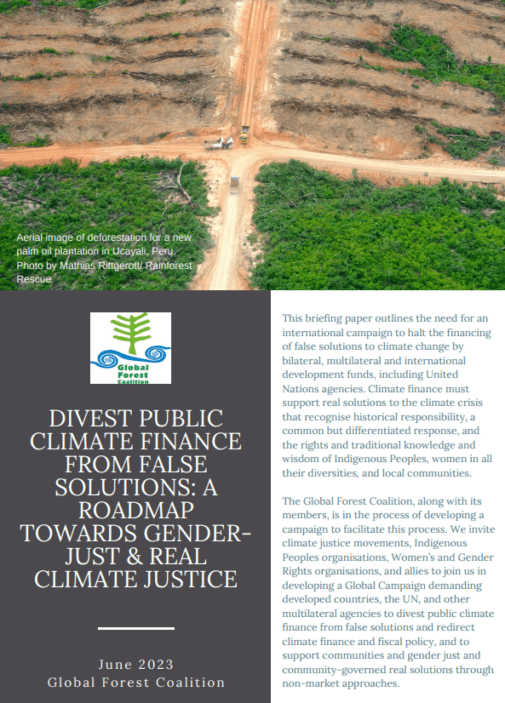World’s Largest Wood Power Station Approved in the UK will Threaten Climate and Forests
Plans were approved on 14 March 2011 to convert RWE npower’s Tilbury B power station from coal to burning imported wood pellets – over 7 million tonnes per year. Biofuelwatch estimates that this would, if implemented, push the UK’s planned demand for biomass to around 60 million tonnes of wood per year (1). This is more than six times the UK’s annual wood production (2) and poses a major threat to forests, local as well as forest-dependent communities and to the climate. RWE claim that most of the wood will be sourced from North America, but they have permission to source it from anywhere.
RWE expects to have the Tilbury power station running on wood by the end of the year. This will nearly double the amount of wood pellets burned in the entire EU – 9 million tones in 2010. RWE will receive around £400m in ‘renewable energy’ financial subsidies a year for this power station alone (3).
Most of the wood to fuel British power stations will have to be imported as the Forestry Commission has calculated that only an additional 2 million tonnes of wood fuel per year could be produced from within England by 2020. This is why these facilities are based at ports like Southampton, Holyhead, Tyneside and Avonmouth, where they will receive shipments of wood from Brazil, the USA, Canada, West Africa, Russia and elsewhere.
RWE, developer of the Tilbury station, is simultaneously pursuing construction of a large pellet manufacturing facility, “Georgia Biomass” in the southeastern US, where they will produce pellets to ship across the Atlantic to burn in Europe, however this could at most supply one tenth of this power station.
Mounting scientific evidence reveals that, far from being ‘carbon neutral’ or ‘clean’, burning biomass on this scale will speed up climate change as well as seriously worsening air pollution. The carbon dioxide released from burning biomass goes straight into the atmosphere and immediately adds to global warming – exactly as it does when burning coal, but because of lower efficiency, each unit of wood electricity generated results in far more upfront carbon emissions than burning coal (4). The theory is that replacement trees or tree growth will recapture the carbon, however, even if those trees are actually planted, it would take decades or even centuries for them to capture the carbon emitted from UK wood power stations. Worse than that, talk of ‘replacement trees’ tends to mean destroying forests for monoculture tree plantations, thus destroying biodiversity, the livelihoods of forest-dependent peoples, depleting and polluting freshwater and eroding soils (5).
Robert Palgrave from Biofuelwatch said:
“Biomass electricity is not sustainable at this scale and in the critical period up to 2020 and even 2050 will worsen rather than improve greenhouse gas emissions. British electricity consumers are subsidizing the destruction of forests in other countries, and accelerating climate change. In addition, the particulate emissions from these facilities will take serious toll on public health.”
Simone Lovera, Managing Director of the Global Forest Coalition added: “If RWE succeed in buying millions of tonnes of wood from North America, this will accelerate the destruction of forests in the US and Canada. It will also displace pulp and paper production further from North America to the global South, causing more destruction of forests, farmlands and communities’ livelihoods.”
Anne Petermann, Executive Director of Global Justice Ecology Project and Coordinator of the STOP GE Trees Campaign stated, “Wood-based bioenergy is the leading force driving development of genetically engineered (GE) trees in the United States, and is becoming a threat in countries like Brazil and various countries in Europe. Industry projects planting half a billion GE eucalyptus trees annually for biomass, just in the US South.(6) Turning our forests into GE bioenergy plantations to burn is in no way a sustainable solution.”
Helena Paul from Econexus adds: “We need immediate emission reductions to avoid runaway climate instability. Large-scale biomass burning makes no sense because it involves releasing more greenhouse gases per unit of energy than coal during the next few critical years, even if this is (in theory) made up by new growth later. This dangerous emissions debt alone should halt developments worldwide such as Tilbury.”
Contacts:
Robert Palgrave, Biofuelwatch, UK: +44.483-762697
Simone Lovera, Global Forest Coalition, Paraguay: +595-21-663654 or +595-981-407375
Helena Paul, Econexus, UK: +44.207 431 4357
Rachel Smolker, Biofuelwatch, US: +1.802 482 2848 or ++1 802 735 7794
Notes:
(1) This figure is calculated by adding up the wood demand for all currently proposed biomass power stations as well as projected demand under the Renewable Heat Incentive in the UK. Planned biomass power stations are shown at http://www.biofuelwatch.org.uk/biomass_map/This list has been collated by Biofuelwatch.
(2) According to the Forestry Commission, total hardwood and softwood production in the UK amounted to 8.7 million tonnes in 2010: www.forestry.gov.uk/website/forstats2010.nsf/LUContentsTop?openview&RestrictToCategory=1 .
(3) Subsidies are paid in the form of Renewable Obligation Certificates (ROCs), through a levy on electricity bills. The £400 million figure is based on the current market rate of ROCs.
(4) See for example The upfront carbon debt of bioenergy, Joanneum Research, May 2010, www.birdlife.org/eu/pdfs/Bioenergy_Joanneum_Research.pdf
(5) Wood-based Bioenergy: The Green Lie, Global Forest Coalition, May 2010, www.globalforestcoalition.org/wp-content/uploads/2010/10/briefing-paper-bioenergy_final_1.pdf
(6) Rubicon 2009 Annual Report www.globaljusticeecology.org/files/ArborGen%202009.pdf








